AutoZone Bundle
Who Really Controls AutoZone?
Understanding the ownership structure of a company is crucial for investors and analysts alike. Knowing who owns AutoZone, a leader in the automotive aftermarket, offers insights into its strategic decisions and future prospects. From its humble beginnings to its current status as a retail giant, AutoZone's ownership has evolved significantly.
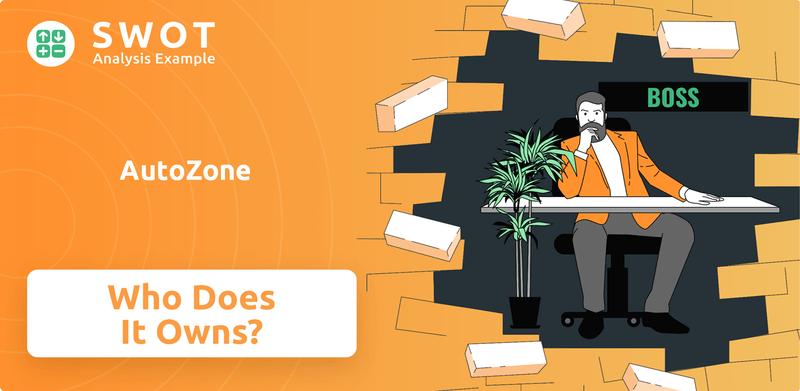
AutoZone's AutoZone SWOT Analysis can provide a deeper understanding of the company's position in the market. This exploration of AutoZone ownership will uncover the key players, from the initial founder to the current major shareholders. We'll examine the AutoZone company's journey, including its initial public offering and the shifts in its ownership profile over time to provide a comprehensive overview of who owns AutoZone.
Who Founded AutoZone?
The origins of the company, initially named Auto Shack, trace back to 1979. It was founded by J.R. 'Pitt' Hyde III. The inception of the company marked the beginning of a significant player in the automotive parts industry.
Hyde's vision for the company was influenced by his experience on the board of directors at Wal-Mart, which inspired him to implement a customer-focused strategy. The inaugural store opened on July 4, 1979, in Forrest City, Arkansas, with Doc Crain as its manager. The first day's sales reached $300.00.
The company's early ownership was primarily held by Hyde through Malone & Hyde, Inc., a wholesale grocery firm. This structure provided the financial backing necessary for the initial expansion and establishment of the business model.
The first store opened in 1979 in Forrest City, Arkansas. The initial focus was on customer service and low prices. This approach set the stage for future growth.
Hyde's inspiration came from Wal-Mart's success. The company aimed to provide excellent customer service. The company's goal was to offer everyday low prices.
Within its first year, seven more stores opened. A warehouse was established in Memphis. By 1980, the company had expanded to 23 stores across seven states.
In 1987, the company changed its name to AutoZone. This change followed a lawsuit. The new name better reflected the company's focus.
In 1988, Hyde sold the Malone & Hyde business. This move allowed Hyde to focus on the AutoZone retail chain. AutoZone became an independent entity.
The initial investment came from Malone & Hyde, Inc. This funding supported the company's early growth. The company's early growth included the opening of seven more stores in Arkansas and Tennessee within its first year, along with a warehouse in Memphis.
The early history of the company reveals a strategic shift from its origins within Malone & Hyde to its emergence as a standalone entity. The company's expansion, name change, and focus on customer service laid the groundwork for its future success. The company's evolution reflects a clear vision and adaptation to market dynamics. For more insights into the company's strategic growth, see Growth Strategy of AutoZone.
AutoZone SWOT Analysis
- Complete SWOT Breakdown
- Fully Customizable
- Editable in Excel & Word
- Professional Formatting
- Investor-Ready Format
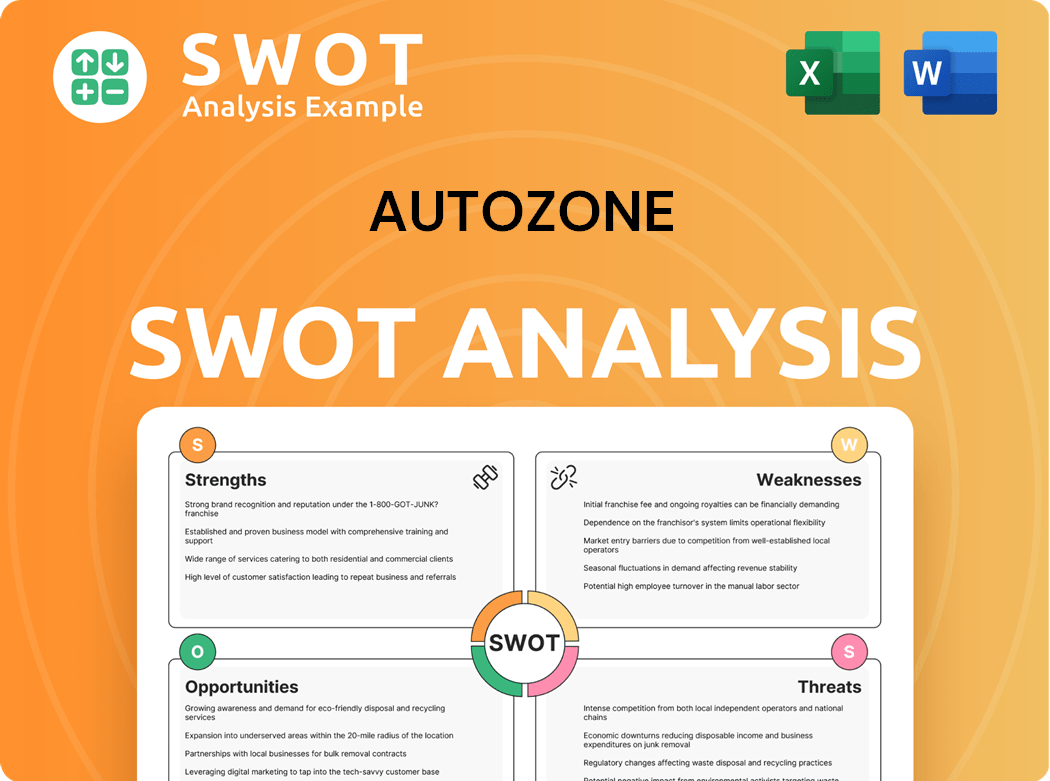
How Has AutoZone’s Ownership Changed Over Time?
The evolution of AutoZone's ownership structure is marked by its initial public offering (IPO) in 1991. This pivotal event, with J.R. 'Pitt' Hyde III and Kohlberg Kravis Roberts & Co. (KKR) taking the company public, listed its stock on the New York Stock Exchange under the ticker symbol 'AZO.' Initially, KKR held a significant portion of the shares. However, they began to divest their holdings by 1993, which significantly reshaped the company's ownership landscape.
The
AutoZone company
has since transitioned to a structure dominated by institutional investors. This shift reflects broader trends in corporate ownership, where large financial entities play a key role. Understanding theAutoZone ownership
and its changes over time is crucial for anyone interested in the company's financial health and strategic direction.| Ownership Category | Percentage of Shares (Approximate) | Shareholders |
|---|---|---|
| Institutional Investors | 94.1% | Insurance companies, investment funds |
| Individual Insiders | 0.25% | Executives, board members |
| General Public | 5.57% | General public |
As of May 2025, the ownership of AutoZone is primarily held by institutional investors. This includes major players like The Vanguard Group, Inc., holding approximately 10.5% of the shares, and BlackRock, Inc., holding about 7.51% of the shares. Other significant institutional shareholders include JPMorgan Chase & Co., State Street Global Advisors, Inc., and Geode Capital Management, LLC. Individual insiders hold a much smaller portion, with the general public owning a small percentage as well. The total outstanding shares were approximately 16.73 million as of March 14, 2025.
Institutional investors are the primary owners of AutoZone, holding the majority of shares.
- The Vanguard Group, Inc. and BlackRock, Inc. are among the largest institutional shareholders.
- Individual insiders hold a very small percentage of the company's stock.
- Understanding the
AutoZone shareholders
provides insight into the company's strategic direction.
AutoZone PESTLE Analysis
- Covers All 6 PESTLE Categories
- No Research Needed – Save Hours of Work
- Built by Experts, Trusted by Consultants
- Instant Download, Ready to Use
- 100% Editable, Fully Customizable
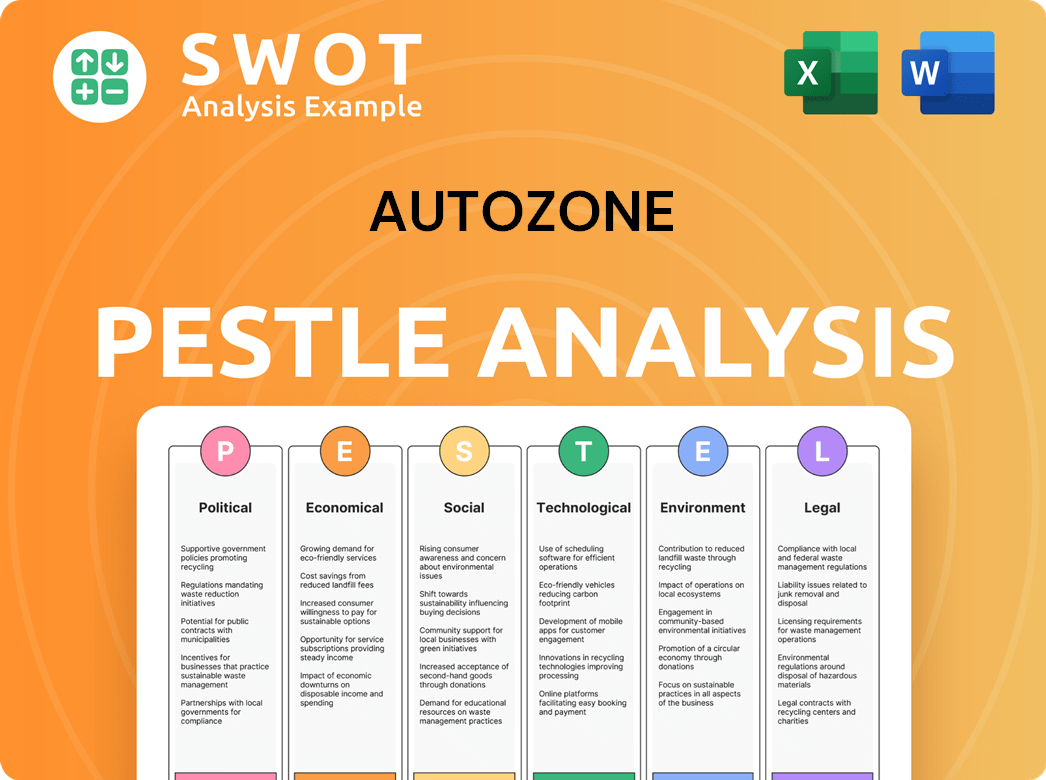
Who Sits on AutoZone’s Board?
As of May 2025, the board of directors for the AutoZone company consists of 11 members. The board recently welcomed Constantino Spas Montesinos. Claire Rauh McDonough was appointed on April 21, 2025, bringing the total to 10 members at that time. Philip B. Daniele, III, serves as the President and CEO, and also holds the combined Chairman role. Earl G. Graves, Jr. acts as the Lead Director, overseeing executive sessions of non-management directors.
The structure of the board includes independent members and chairs for each of its committees. The roles of Chairman and CEO are combined, but the board regularly reviews this structure. This approach aims to maintain strong independent oversight while ensuring clear strategic alignment. This structure is crucial for understanding the AutoZone ownership and how the company is governed.
| Director | Title | |
|---|---|---|
| Philip B. Daniele, III | Director, President and CEO | |
| Michael George | Director | |
| Linda A. Goodspeed | Director | |
| Earl G. Graves, Jr. | Lead Director | |
| Brian Hannasch | Director | |
| Gale V. King | Director | |
| Claire Rauh McDonough | Director | (Appointed April 21, 2025) |
| Constantino Spas Montesinos | Director | (Appointed May 28, 2025) |
| George R. Mrkonic, Jr. | Director | |
| William C. Rhodes III | Executive Chairman |
AutoZone's voting structure is based on one share, one vote. Shareholders can vote in person, by proxy, or online. A quorum for shareholder meetings requires a majority of the voting power of the company's stock. The company's corporate governance emphasizes independent oversight, with committees like Audit, Compensation, and Nominating composed of independent directors. Understanding the AutoZone shareholders and the company's history is key to grasping its ownership structure. For more insights into the company's strategic approach, consider reading about the Target Market of AutoZone.
The board of directors includes a mix of experienced executives and independent members, ensuring diverse perspectives in decision-making.
- The Lead Director oversees executive sessions of non-management directors, promoting independent oversight.
- Voting is straightforward: one share equals one vote, making the process accessible to all shareholders.
- Independent committees ensure transparency and accountability in key areas like audit and compensation.
- The board regularly evaluates its structure to optimize leadership and strategic alignment.
AutoZone Business Model Canvas
- Complete 9-Block Business Model Canvas
- Effortlessly Communicate Your Business Strategy
- Investor-Ready BMC Format
- 100% Editable and Customizable
- Clear and Structured Layout
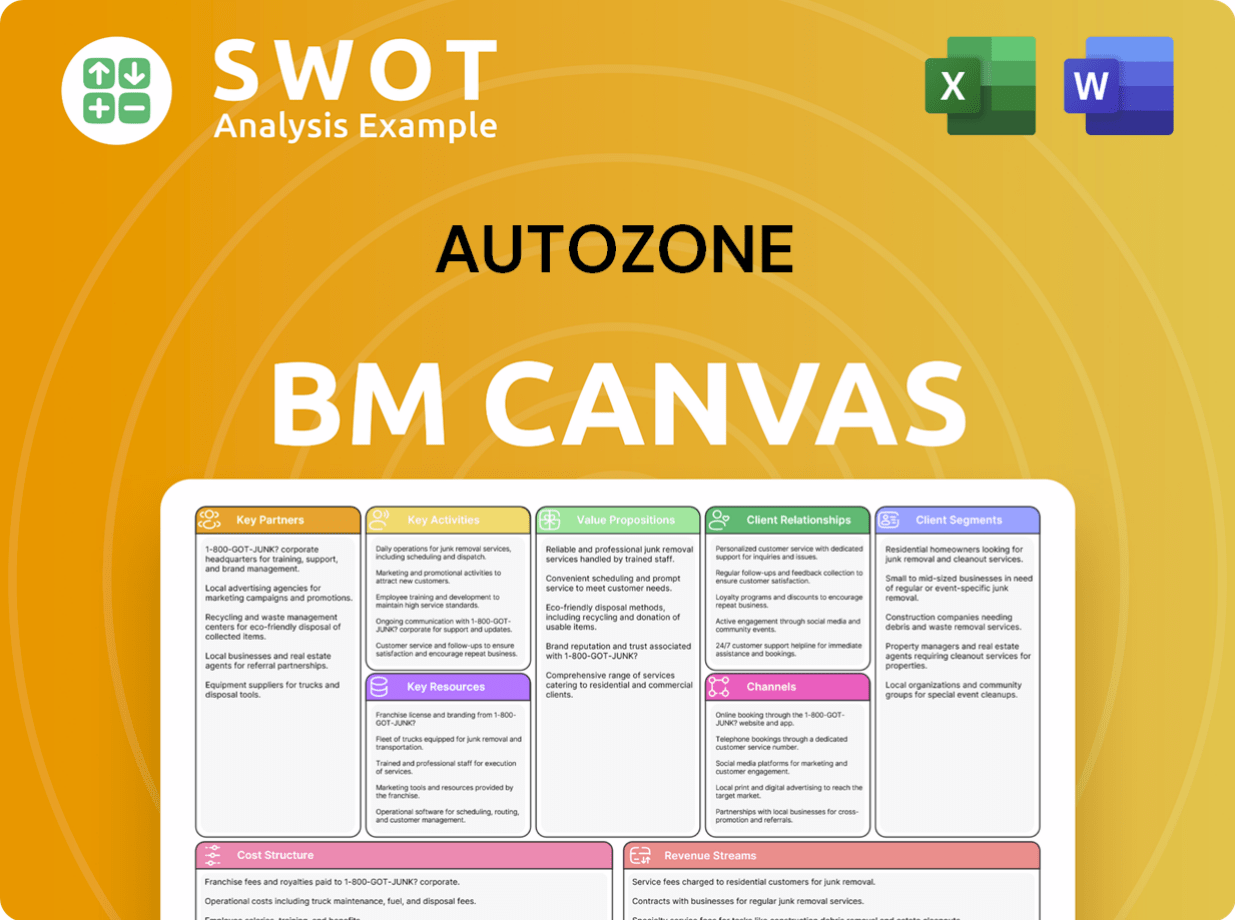
What Recent Changes Have Shaped AutoZone’s Ownership Landscape?
In the past few years, the AutoZone company has shown a consistent trend in its ownership profile. Institutional investors continue to dominate, reflecting a strong belief in the company's performance. As of May 2025, institutional investors hold a substantial 98.18% of the shares, demonstrating their confidence in AutoZone's future. This trend highlights the company's stability and attractiveness to large financial entities.
AutoZone's commitment to shareholder value is evident through its share repurchase programs. Since 1998, the Board of Directors has authorized approximately $39.2 billion in share repurchases. The company has consistently bought back shares, including $505.21 million in the first quarter of fiscal 2025 (ended November 23, 2024). In the second quarter of fiscal 2025 (ended February 15, 2025), 100,000 shares were repurchased for $329.4 million, and $1.3 billion remained under the current authorization. In the third quarter of fiscal 2025 (ended May 10, 2025), 70,000 shares were repurchased for $250.3 million, with $1.1 billion remaining under the authorization. This aggressive approach underscores AutoZone’s strategy to enhance shareholder returns.
| Metric | Details | Date |
|---|---|---|
| Institutional Ownership | 98.18% | May 2025 |
| Share Repurchase Authorization | $39.2 billion (cumulative) | Since 1998 |
| Share Repurchases (Q1 FY2025) | $505.21 million | Ended November 23, 2024 |
The leadership at AutoZone has seen some changes, including a transition plan completed in January 2024. The board has also been refreshed with new appointments, such as Claire Rauh McDonough in April 2025 and Constantino Spas Montesinos in May 2025, bringing the board to 11 members. These moves reflect AutoZone's focus on strong governance and strategic direction, ensuring the company is well-positioned for future growth. To understand the competitive landscape, consider the Competitors Landscape of AutoZone.
Institutional investors hold the majority of AutoZone's shares, showcasing strong confidence.
AutoZone has a history of share buybacks, returning value to shareholders.
The board has been refreshed with new members to enhance governance and strategic direction.
Institutional ownership remains dominant, with share repurchases as a key strategy.
AutoZone Porter's Five Forces Analysis
- Covers All 5 Competitive Forces in Detail
- Structured for Consultants, Students, and Founders
- 100% Editable in Microsoft Word & Excel
- Instant Digital Download – Use Immediately
- Compatible with Mac & PC – Fully Unlocked
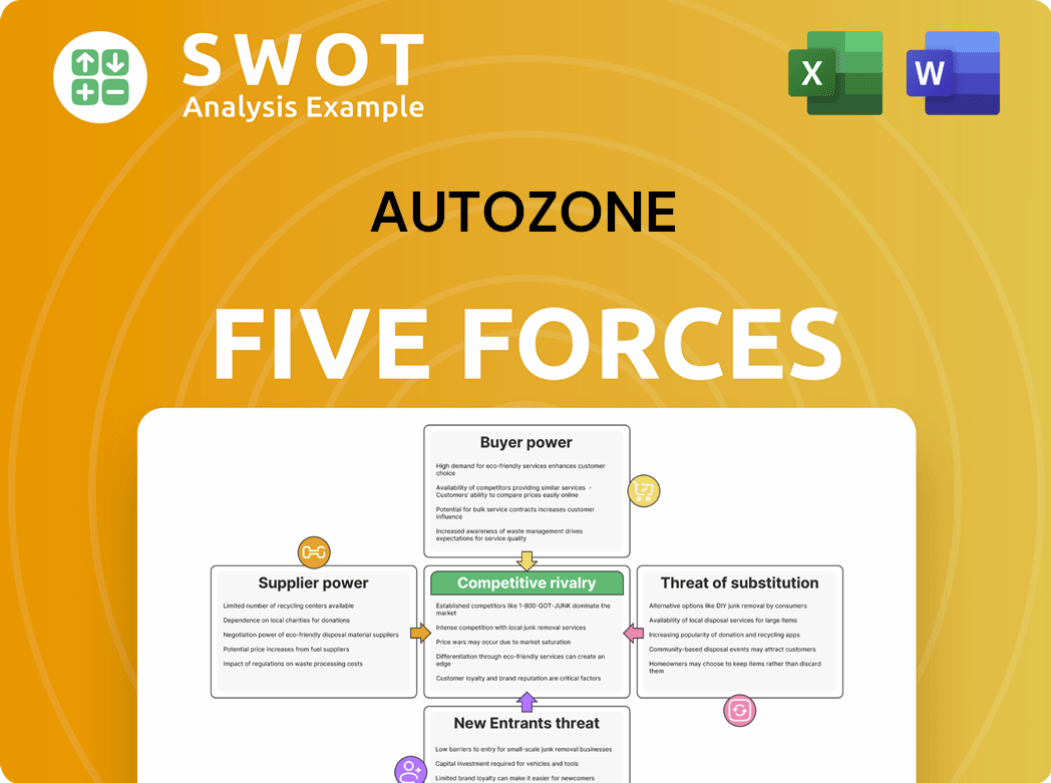
Related Blogs
- What are Mission Vision & Core Values of AutoZone Company?
- What is Competitive Landscape of AutoZone Company?
- What is Growth Strategy and Future Prospects of AutoZone Company?
- How Does AutoZone Company Work?
- What is Sales and Marketing Strategy of AutoZone Company?
- What is Brief History of AutoZone Company?
- What is Customer Demographics and Target Market of AutoZone Company?
Disclaimer
All information, articles, and product details provided on this website are for general informational and educational purposes only. We do not claim any ownership over, nor do we intend to infringe upon, any trademarks, copyrights, logos, brand names, or other intellectual property mentioned or depicted on this site. Such intellectual property remains the property of its respective owners, and any references here are made solely for identification or informational purposes, without implying any affiliation, endorsement, or partnership.
We make no representations or warranties, express or implied, regarding the accuracy, completeness, or suitability of any content or products presented. Nothing on this website should be construed as legal, tax, investment, financial, medical, or other professional advice. In addition, no part of this site—including articles or product references—constitutes a solicitation, recommendation, endorsement, advertisement, or offer to buy or sell any securities, franchises, or other financial instruments, particularly in jurisdictions where such activity would be unlawful.
All content is of a general nature and may not address the specific circumstances of any individual or entity. It is not a substitute for professional advice or services. Any actions you take based on the information provided here are strictly at your own risk. You accept full responsibility for any decisions or outcomes arising from your use of this website and agree to release us from any liability in connection with your use of, or reliance upon, the content or products found herein.